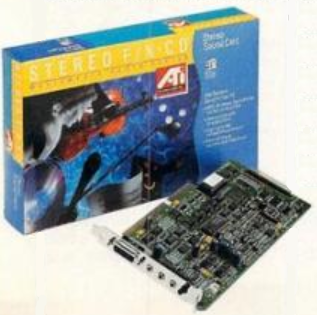ATI Stereo F/X and VGA Stereo F/X
Launched in 1992, The VGA Stereo F/X combined a VGA Wonder XL with a Sound Blaster 1.5 onto a single 16-bit ISA card. The Stereo F/X was a cut-down card that omitted the video circuitry.
.png) |
Released | 1992 |
| Bus | ISA 16-bit | |
| Chipset | ATi 28800 (VGA Stereo F/X only) | |
| Standards | VGA and SVGA (VGA Stereo F/X only) | |
| Memory | 512 KB or 1 MB DRAM | |
| Ports | 15-pin DSUB for RGB analogue (VGA Stereo F/X only) 15-pin DSUB for audio in/out |
|
| FM Synth | Yamaha YM3812 (OPL2) | |
| Part # | ||
| FCC ID | EXMVGAFX (VGA F/X), EXMAUDIOFX (Stereo F/X), EXM200 (Stereo F/X CD) | |
| Price | $449 (launch price, VGA Stereo F/X 512 KB), $499 (launch price, VGA Stereo F/X 1 MB), $95/$139 (Nov 1993, Stereo FX/ Stereo FX CD) |
It features 'fake' stereo sound when playing back mono sound files, believed to be achieved by separating frequencies and playing different ones back on left and right channels.
The card's faceplate has a mini-DIN port which is for a Microsoft InPort mouse, the lower connector is the VGA video output, and the one at the top of the faceplate is for audio output, which uses a proprietary dongle. If you are missing this dongle the main audio pins are as follows: pin 2 is Audio-R, pin 11 is Audio-L, and pin 26 is GND.
The two [usually] empty sockets near the top-left of the card are for Creative Labs' optional CMS chips (Philips SA1099).
The 512 KB version gives you 640 x 480 and 800 x 600 resolutions in 256 colours and 1024 x 768 in 16 colours. The 1 MB version gives you 1024 x 768 in 256 colours. At the lower resolutions of 640 x 480 and 800 x 600 this card supports 32,768 simutaneous colours with its use of the Sierra Hi-Color RAMDAC chip. The VGA Stereo F/X supports up to 72 Hz refresh rates but you needed the full 1MB DRAM version for this to work in SVGA modes.
It has a real OPL2 chip but can also use Creative's CMS chips, making it CMS-/Game Blaster-compatible if you install these. All settings such as base address, IRQ and DMA channel are stored in an EPROM chip, so there are no jumpers to configure on this board. The utility disk contains a config program. It's a very loud sound card (audibly), as all sound is output through an onboard 8-watt amplifier.
Two other versions of this were released the same year:
The Stereo F/X, unlike the VGA Stereo F/X was just the sound card portion (no VGA capability). On its faceplate were two 3.5mm jacks - one for audio in, one for audio out), and a 15-pin game port. The audio aspects of the card were the same as that found on the VGA Stereo F/X - compatible with the Ad Lib and Sound Blaster standards, with an 8-bit ADC for 44.1 kHz mono or 22.05 kHz stereo output. I don't believe the game port is MIDI UART-compatible - if this is incorrect, let me know.
ATI Stereo F/X CD lacked the Creative Labs CMS chip sockets but gained a 40-pin Mitsumi CD-ROM interface header, a 4-pin PC speaker header, and a CD Audio 26-pin header. It also replaced the proprietary audio port with 3.5mm jacks. Unlike the other two however, the audio part of the Stereo F/X CD was a more enhanced 20-voice FM Music Synthesizer (4 operator OPL3), replacing the 11-voice OPL2 of the other two models. The Stereo F/X-CD has no jumpers - it's configured entirely via software. It came bundled with a cable for re-routing the PC speaker through the Stereo F/X CD card. The two provided 5.25-inch floppy disks included Universal DOS and Windows drivers, plus a few other useful tools including a mixer. These include WinDAT and DOSDat - written by Voyetra Technologies, they provide an interface similar to the controls on a stereo system or high-end tape deck. In November 1993, ATI announced their new CD Sound Dimension Multimedia Upgrade Kit ($399), which included a Mitsumi CD-ROM drive, the Stereo F/X CD sound card, and a number of applications on two CD-ROMs.
I believe the video/audio BIOS ROM firmware is the same across all three models of the card. This is stored in a 28-pin DIP EPROM chip which is a Texas Instruments TMS27C256 or equivalent.
Summing Up: Looking at the two 'audio only' models, the Stereo F/X is the budget model with only 11-voice OPL2 output, so the Stereo F/X CD is the one to go for out of this pair with its 20-voice OPL3 compatibility.
A few games supported the Stereo F/X cards directly, including Microprose's Gunship 2000.
Board Revisions
Competition
In the Media
Setting it Up
No information at present.
Downloads
DOS Drivers DOS-based setup and configuration utilities for the VGA Stereo F/X card (Disks 1 and 2). Includes Microstation 4.0 and AutoCAD for DOS drivers. |
DOS Setup & Utilities DOS-based setup and configuration utilities for the Stereo F/X card. |
DOS Setup & Utilities DOS-based setup and configuration utilities for the Stereo F/X CD card. Includes support for Windows 3.1. |
Windows 3.1 Audio Drivers Windows 3.1x sound drivers for the audio portion of the VGA Stereo F/X |
Windows 3.1 Video Drivers Windows 3.1x display drivers for the graphics controller on the VGA Stereo F/X |
ATI Mouse Driver Mouse driver for DOS. Works with Stereo F/X, VGA Stereo F/X, VGA Wonder XL, 8514/Ultra, Graphics Ultra, Graphics Vantage and all other legacy ATI cards with a bus mouse port. |
ATI Mouse Driver ATI mouse driver v7.04 for DOS for all ATI products that have a mouse port |
Reset Utility Updated RESET.EXE program which clears the INTERRUPT QUEUE. |
|


.png)